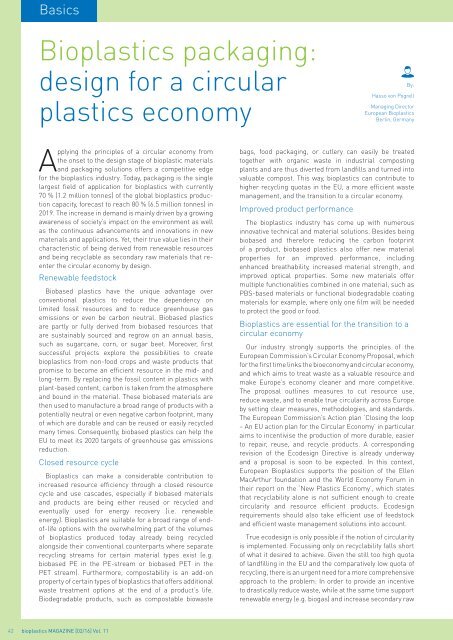Issue 02/2016
bioplasticsMAGAZINE_1602
bioplasticsMAGAZINE_1602
You also want an ePaper? Increase the reach of your titles
YUMPU automatically turns print PDFs into web optimized ePapers that Google loves.
Basics<br />
Bioplastics packaging:<br />
design for a circular<br />
plastics economy<br />
By:<br />
Hasso von Pogrell<br />
Managing Director<br />
European Bioplastics<br />
Berlin, Germany<br />
Applying the principles of a circular economy from<br />
the onset to the design stage of bioplastic materials<br />
and packaging solutions offers a competitive edge<br />
for the bioplastics industry. Today, packaging is the single<br />
largest field of application for bioplastics with currently<br />
70 % (1.2 million tonnes) of the global bioplastics production<br />
capacity, forecast to reach 80 % (6.5 million tonnes) in<br />
2019. The increase in demand is mainly driven by a growing<br />
awareness of society’s impact on the environment as well<br />
as the continuous advancements and innovations in new<br />
materials and applications. Yet, their true value lies in their<br />
characteristic of being derived from renewable resources<br />
and being recyclable as secondary raw materials that reenter<br />
the circular economy by design.<br />
Renewable feedstock<br />
Biobased plastics have the unique advantage over<br />
conventional plastics to reduce the dependency on<br />
limited fossil resources and to reduce greenhouse gas<br />
emissions or even be carbon neutral. Biobased plastics<br />
are partly or fully derived from biobased resources that<br />
are sustainably sourced and regrow on an annual basis,<br />
such as sugarcane, corn, or sugar beet. Moreover, first<br />
successful projects explore the possibilities to create<br />
bioplastics from non-food crops and waste products that<br />
promise to become an efficient resource in the mid- and<br />
long-term. By replacing the fossil content in plastics with<br />
plant-based content, carbon is taken from the atmosphere<br />
and bound in the material. These biobased materials are<br />
then used to manufacture a broad range of products with a<br />
potentially neutral or even negative carbon footprint, many<br />
of which are durable and can be reused or easily recycled<br />
many times. Consequently, biobased plastics can help the<br />
EU to meet its 2<strong>02</strong>0 targets of greenhouse gas emissions<br />
reduction.<br />
Closed resource cycle<br />
Bioplastics can make a considerable contribution to<br />
increased resource efficiency through a closed resource<br />
cycle and use cascades, especially if biobased materials<br />
and products are being either reused or recycled and<br />
eventually used for energy recovery (i.e. renewable<br />
energy). Bioplastics are suitable for a broad range of endof-life<br />
options with the overwhelming part of the volumes<br />
of bioplastics produced today already being recycled<br />
alongside their conventional counterparts where separate<br />
recycling streams for certain material types exist (e.g.<br />
biobased PE in the PE-stream or biobased PET in the<br />
PET stream). Furthermore, compostability is an add-on<br />
property of certain types of bioplastics that offers additional<br />
waste treatment options at the end of a product’s life.<br />
Biodegradable products, such as compostable biowaste<br />
bags, food packaging, or cutlery can easily be treated<br />
together with organic waste in industrial composting<br />
plants and are thus diverted from landfills and turned into<br />
valuable compost. This way, bioplastics can contribute to<br />
higher recycling quotas in the EU, a more efficient waste<br />
management, and the transition to a circular economy.<br />
Improved product performance<br />
The bioplastics industry has come up with numerous<br />
innovative technical and material solutions. Besides being<br />
biobased and therefore reducing the carbon footprint<br />
of a product, biobased plastics also offer new material<br />
properties for an improved performance, including<br />
enhanced breathability, increased material strength, and<br />
improved optical properties. Some new materials offer<br />
multiple functionalities combined in one material, such as<br />
PBS-based materials or functional biodegradable coating<br />
materials for example, where only one film will be needed<br />
to protect the good or food.<br />
Bioplastics are essential for the transition to a<br />
circular economy<br />
Our industry strongly supports the principles of the<br />
European Commission’s Circular Economy Proposal, which<br />
for the first time links the bioeconomy and circular economy,<br />
and which aims to treat waste as a valuable resource and<br />
make Europe’s economy cleaner and more competitive.<br />
The proposal outlines measures to cut resource use,<br />
reduce waste, and to enable true circularity across Europe<br />
by setting clear measures, methodologies, and standards.<br />
The European Commission’s Action plan ‘Closing the loop<br />
– An EU action plan for the Circular Economy’ in particular<br />
aims to incentivise the production of more durable, easier<br />
to repair, reuse, and recycle products. A corresponding<br />
revision of the Ecodesign Directive is already underway<br />
and a proposal is soon to be expected. In this context,<br />
European Bioplastics supports the position of the Ellen<br />
MacArthur foundation and the World Economy Forum in<br />
their report on the ‘New Plastics Economy’, which states<br />
that recyclability alone is not sufficient enough to create<br />
circularity and resource efficient products. Ecodesign<br />
requirements should also take efficient use of feedstock<br />
and efficient waste management solutions into account.<br />
True ecodesign is only possible if the notion of circularity<br />
is implemented. Focussing only on recyclability falls short<br />
of what it desired to achieve. Given the still too high quota<br />
of landfilling in the EU and the comparatively low quota of<br />
recycling, there is an urgent need for a more comprehensive<br />
approach to the problem: In order to provide an incentive<br />
to drastically reduce waste, while at the same time support<br />
renewable energy (e.g. biogas) and increase secondary raw<br />
42 bioplastics MAGAZINE [<strong>02</strong>/16] Vol. 11


















